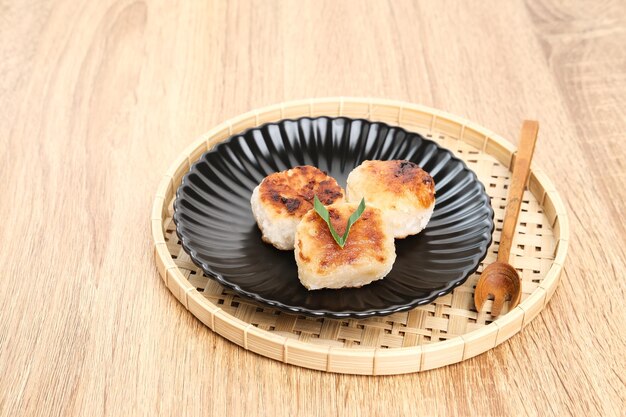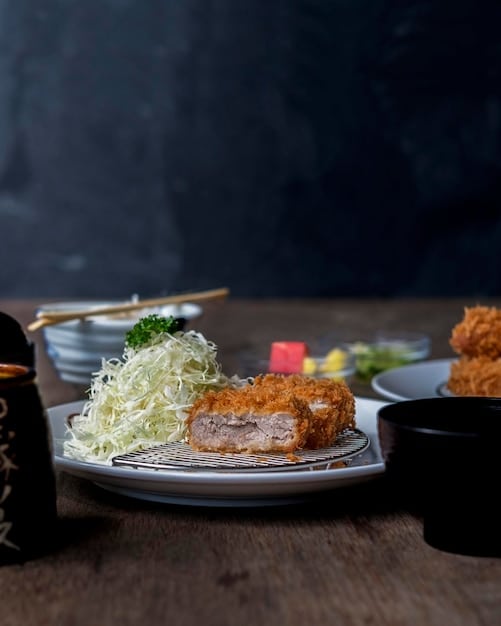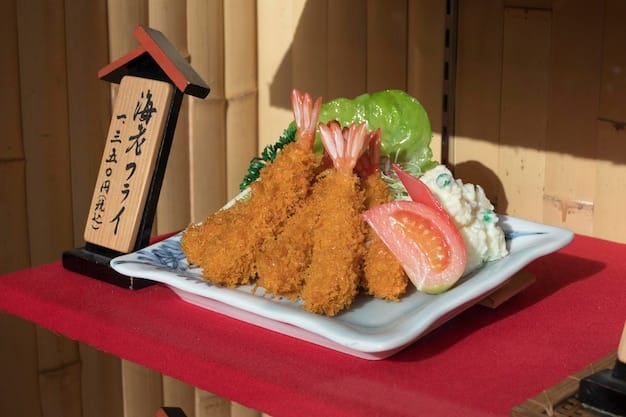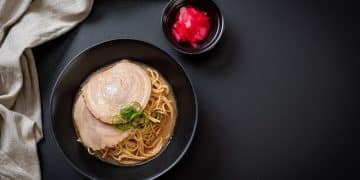Katsu Craze: A Delicious Guide to Japanese Cutlets in the US

Katsu, a breaded and deep-fried Japanese cutlet, has taken the US by storm with dishes like tonkatsu (pork) and chicken katsu—explore the flavorful history, variations, and best spots to enjoy this culinary trend sweeping across the country.
The katsu craze: from tonkatsu to chicken katsu, a guide to Japanese cutlets has swept across the United States, bringing a delightful crunch and savory flavors to menus nationwide. But what exactly is katsu, and why is it so popular?
What is Katsu? Unveiling the Japanese Cutlet Sensation
Katsu is a Japanese dish that consists of a breaded and deep-fried cutlet of meat. The term “katsu” is actually a shortened version of “Katsuretsu,” which is derived from the English word “cutlet.” This culinary creation has become a beloved staple in Japan and has rapidly gained popularity in the United States.
The beauty of katsu lies in its simplicity and versatility. The basic concept involves coating a cut of meat in flour, egg, and panko breadcrumbs before deep-frying it to golden perfection. The result is a crispy, savory delight that can be enjoyed in various forms.
The Origins of Katsu
Katsu’s roots can be traced back to the late 19th century during the Meiji Restoration in Japan. As Japan opened its doors to Western influence, Western cuisine began to make its way into Japanese culinary traditions. Katsuretsu, inspired by European cutlets, emerged as a fusion dish, blending Western techniques with Japanese flavors.
Initially, beef was the primary meat used for katsuretsu. However, pork soon became the more popular choice, leading to the creation of tonkatsu, which is now considered the quintessential katsu dish. Over time, variations using chicken, shrimp, and even vegetables have emerged, catering to diverse tastes and preferences.
Katsu quickly gained popularity as a readily available and affordable meal. It was often served in yoshoku restaurants, establishments that specialized in Western-influenced Japanese cuisine. It eventually made its way into homes as well, becoming a staple family dish.
- Meiji Restoration Influence: The adoption of Western culinary techniques marked a pivotal moment in the development of katsu.
- Evolution from Beef to Pork: The shift to pork as the primary meat source led to the iconic dish we know as tonkatsu.
- Yoshoku Restaurant Boom: These establishments played a crucial role in popularizing katsu among the Japanese population.
Today, katsu continues to evolve, with chefs exploring new flavors, ingredients, and presentation styles. It’s not just a simple breaded cutlet; it’s a canvas for culinary creativity.
Tonkatsu: The King of Katsu
Tonkatsu stands as the most iconic and widely recognized type of katsu. This dish features a succulent pork cutlet that has been expertly breaded and deep-fried. Tonkatsu is not just a dish; it is a symbol of Japanese comfort food, cherished for its satisfying crunch and savory depth.
Typically, tonkatsu utilizes either pork loin or pork fillet. The meat is tenderized, seasoned, coated in flour, dipped in egg, and then generously covered in panko breadcrumbs. The breaded cutlet is then submerged in hot oil, where it transforms into a golden-brown masterpiece.
The Perfect Tonkatsu Experience
What sets tonkatsu apart is its perfect balance of textures and flavors. The panko breadcrumbs create a crispy and airy crust, while the pork inside remains juicy and tender. The interplay of these textures makes each bite a delight.
Tonkatsu is traditionally served with a tangy and slightly sweet tonkatsu sauce, which is made from a blend of fruits, vegetables, and spices. The sauce complements the richness of the pork, enhancing the overall flavor profile.
Common accompaniments to tonkatsu include shredded cabbage, which adds a refreshing crunch, and steamed rice, which provides a comforting base. Miso soup and Japanese pickles are also frequently served as side dishes.
- Pork Loin or Fillet: Choosing the right cut of pork is crucial for achieving tenderness and flavor.
- Panko Breadcrumbs: The use of coarse panko creates the signature crispy texture of tonkatsu.
- Tonkatsu Sauce: This unique sauce enhances the flavor of the pork and ties the dish together.
Tonkatsu has transcended its humble origins to become a global culinary phenomenon, enjoyed by people of all ages and backgrounds.

Chicken Katsu: A Lighter and Equally Delicious Option
While tonkatsu reigns supreme, chicken katsu offers a lighter and equally delicious alternative. This variation substitutes pork with chicken, providing a leaner protein option while retaining the signature katsu crunch and flavor.
Chicken katsu is made using chicken breast or thigh meat. The chicken is prepared in the same manner as tonkatsu: tenderized, seasoned, coated in flour, egg, and panko breadcrumbs, and then deep-fried to a golden-brown perfection.
Many people appreciate chicken katsu for its versatility. It can be used in various dishes, from katsu curry to katsu sandwiches, making it a favorite among those seeking a quick and satisfying meal.
Why Choose Chicken Katsu?
Chicken katsu offers several advantages over its pork counterpart. It is generally lower in fat and calories, making it a healthier option for those watching their diet. Additionally, chicken has a milder flavor, allowing the katsu sauce and other accompaniments to shine.
Chicken katsu is also a hit with children and picky eaters, thanks to its familiar flavor and crispy texture. It’s a great way to introduce them to Japanese cuisine in a palatable and enjoyable way.
Aside from the health and kid-friendly factors, it’s quick and easy to replicate at home too.
- Lower Fat Content: Chicken katsu is a healthier alternative for those seeking a lighter meal.
- Versatility in Dishes: It’s a versatile ingredient that can be used in various recipes.
- Kid-Friendly Appeal: The familiar flavor and crispy texture make it a hit with children.
Whether you’re a fan of pork or prefer chicken, katsu offers something for everyone.
Beyond Pork and Chicken: Exploring Katsu Variations
The world of katsu extends far beyond tonkatsu and chicken katsu. As katsu has spread across Japan and the world, chefs have experimented with different ingredients and flavors, resulting in a diverse array of katsu variations.
One popular variation is menchi-katsu, which features a ground meat patty that is breaded and deep-fried. This dish is similar to a croquette and is often served with tonkatsu sauce or Worcestershire sauce.
Another variation is ebi-katsu, which uses shrimp as the main ingredient. Ebi-katsu is made by forming a patty of minced shrimp, breading it, and deep-frying it until golden brown.
Vegetarian Katsu Options
For vegetarians, there are several katsu options available. Vegetable katsu can be made using a variety of vegetables, such as eggplant, sweet potato, or mushrooms. These vegetables are sliced, breaded, and deep-fried, creating a crispy and flavorful vegetarian dish.
Tofu katsu is another popular vegetarian option. Tofu is sliced, pressed to remove excess moisture, breaded, and then deep-fried or pan-fried until golden brown.
These vegetarian katsu variations offer a plant-based alternative to traditional meat-based katsu dishes, allowing vegetarians and vegans to enjoy the katsu experience.
- Menchi-Katsu: Ground meat patties offer a twist on the classic cutlet.
- Ebi-Katsu: Shrimp-based katsu provides a seafood alternative.
- Vegetable and Tofu Katsu: Vegetarian options cater to diverse dietary preferences, but the traditional flavors and textures are preserved.
Exploring these katsu variations allows you to discover new flavors and textures within the realm of Japanese cuisine.

Katsu Around the US: Where to Find the Best Cutlets
As the katsu craze continues to sweep the United States, more and more restaurants are adding katsu to their menus. From traditional Japanese eateries to modern fusion restaurants, katsu can be found in various forms and settings across the country.
If you’re looking for an authentic tonkatsu experience, you can explore Japantown in San Francisco or Little Tokyo in Los Angeles. These vibrant neighborhoods are home to numerous Japanese restaurants that specialize in tonkatsu and other Japanese dishes.
Popular Katsu Spots in the US
In New York City, you can find katsu at izakayas (Japanese pubs) and ramen shops. Many of these establishments put their own spin on katsu, offering unique flavor combinations and presentation styles.
In other parts of the US, you can find katsu at Japanese restaurants, food trucks, and even some mainstream restaurants. Many chefs are incorporating katsu into their menus as a way to add a touch of Japanese flair to their dishes.
Whether you’re in a big city or a small town, there’s a good chance you can find katsu somewhere nearby. Just do a little searching online or ask around, and you’re sure to discover a hidden gem serving up delicious katsu.
- Japantown and Little Tokyo: These neighborhoods offer authentic katsu experiences in the US.
- Izakayas and Ramen Shops: In NYC and other cities, these spots often feature creative katsu dishes.
- Local Japanese Restaurants: Many local restaurants now offer katsu, making it accessible throughout the US.
Enjoy taking the time to explore the katsu scene in the US, and don’t be afraid to try new variations and combinations.
Making Katsu at Home: A Step-by-Step Guide
While trying katsu at restaurants is a great way to experience its flavors, making it at home can be a fun and rewarding culinary adventure. With the right ingredients and a little practice, you can create restaurant-quality katsu in your own kitchen.
To make katsu at home, you’ll need meat (pork, chicken, or your preferred protein), flour, eggs, panko breadcrumbs, and oil for deep-frying. You’ll also need a few basic kitchen tools, such as a cutting board, knife, bowls, and a deep pot or fryer.
Essential Steps for Perfect Home-Made Katsu
Start by preparing the meat. If using pork or chicken, slice it into cutlets about ½ inch thick. Tenderize the cutlets by pounding them with a meat mallet or rolling pin.
Next, set up a breading station. Place flour in one bowl, beaten eggs in another, and panko breadcrumbs in a third bowl. Dredge each cutlet in flour, dip it in egg, and then coat it thoroughly in panko breadcrumbs.
Heat oil in a deep pot or fryer to 350°F (175°C). Carefully place the breaded cutlets in the hot oil, being careful not to overcrowd the pot. Fry the cutlets for 3-4 minutes per side, until golden brown and cooked through.
- Meat Preparation: Slicing and tenderizing the meat ensures even cooking and tenderness.
- Breading Station Setup: A well-organized breading station streamlines the process.
- Frying Technique: Monitoring the oil temperature and avoiding overcrowding are key to crispy, evenly cooked katsu.
Once the katsu is cooked, remove it from the oil and place it on a wire rack to drain excess oil. Serve it immediately with tonkatsu sauce, shredded cabbage, and steamed rice, and revel in your homemade triumph.
| Key Point | Brief Description |
|---|---|
| 🇯🇵 Katsu Origins | Inspired by Western cutlets, katsu emerged in Japan during the Meiji Restoration. |
| 🐷 Tonkatsu | The classic pork cutlet, coated in panko and served with tonkatsu sauce, cabbage, and rice. |
| 🐔 Chicken Katsu | A lighter alternative using chicken breast, ideal for quick meals and picky eaters. |
| Vegetarian Katsu | Options using vegetables or tofu to allow vegetarians to enjoy similar textures and flavors. |
FAQ About Katsu
▼
Tonkatsu specifically refers to a pork cutlet, while “katsu” is a general term for any breaded and deep-fried cutlet. So, tonkatsu is a type of katsu, but not all katsu is tonkatsu.
▼
Panko is a type of Japanese breadcrumb made from crustless white bread. It has a larger, flakier texture than regular breadcrumbs, which results in a crispier coating when fried.
▼
Tonkatsu sauce is a thick, fruity, and savory sauce typically made from a blend of fruits, vegetables, vinegar, soy sauce, and spices. It is similar to Worcestershire sauce, but sweeter.
▼
Yes, you can bake katsu for a healthier alternative. Preheat your oven to 400°F (200°C), place the breaded cutlets on a baking sheet, and bake for about 20-25 minutes, flipping halfway through.
▼
Popular side dishes include shredded cabbage, steamed rice, miso soup, Japanese pickles (tsukemono), and katsu curry. These sides complement the rich and savory flavor of katsu.
Conclusion
From its humble beginnings to its current status as a global culinary phenomenon, katsu – whether tonkatsu, chicken katsu, or any other variation – offers a delightful combination of textures and flavors that appeals to a wide range of palates. Whether you’re enjoying it at a restaurant or making it at home, katsu is a dish that’s sure to satisfy your cravings.





